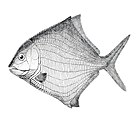Aetheretmon
Appearance
| Aetheretmon Temporal range:
| |
|---|---|

| |
| Aetheretmon valentiacum fossil | |
| Scientific classification | |
| Domain: | Eukaryota |
| Kingdom: | Animalia |
| Phylum: | Chordata |
| Class: | Actinopterygii |
| Family: | †Strepheoschemidae |
| Genus: | †Aetheretmon White, 1927 |
| Species: | †A. valentiacum
|
| Binomial name | |
| †Aetheretmon valentiacum White, 1927
| |
| Synonyms | |
|
Aetherthmon White, 1927 | |
Aetheretmon is an extinct genus of prehistoric freshwater and estuarine ray-finned fish that lived during the early Mississippian (Dinantian) age in what is now Europe, including Scotland, Belarus, and Russia.[1] It contains only the species A. valentiacum.[2] This genus has the oldest known actinopterygian growth series, indicating that juvenile Aetheretmon had tails similar to those of modern teleosts, but unlike teleosts, their upper tails continued to grow throughout their lives instead of truncating early.[3][4] Initially classified as a "palaeoniscid", later studies have recovered it as a stem-neopterygian, or more recently a stem-actinopteran.[2][3]
See also
[edit]References
[edit]- ^ "PBDB". paleobiodb.org. Retrieved 2024-02-01.
- ^ a b Gardiner, Brian G. (1985). "Actinopterygian fish from the Dinantian of Foulden, Berwickshire, Scotland". Transactions of the Royal Society of Edinburgh: Earth Sciences. 76: 61–67. doi:10.1017/S0263593300010312.
- ^ a b Sallan, Lauren (2016). "Fish 'tails' result from outgrowth and reduction of two separate ancestral tails". Current Biology. 26 (23): R1224–R1225. doi:10.1016/j.cub.2016.10.036. ISSN 0960-9822.
- ^ "Fish fossils reveal how tails evolved, Penn professor finds". EurekAlert!. Retrieved 2024-02-01.
Categories:
- Monotypic prehistoric ray-finned fish genera
- Carboniferous fish of Europe
- Carboniferous bony fish
- Mississippian fish
- Carboniferous Scotland
- Fossils of Scotland
- Fossils of Russia
- Fossils of Belarus
- Tournaisian life
- Viséan genera
- Mississippian genus extinctions
- Fossil taxa described in 1927
- Taxa named by Errol White
- Prehistoric ray-finned fish stubs








